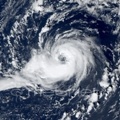Yes, it is interesting that the Brasilian met. service didn't name this system since they classified much more disorganized and extratropical-looking systems as a subtropical storm in the past. There was also a similar (and a bit more tropical) looking cyclone in last March which didn't got classification. [Youtube]https://www.youtube.com/watch?v=Uz5PZN4V6u8[/Youtube]
In this case, there was a long occlusion front near the small cyclone, but it is questionable how it was attached to each other. The ASCAT pass at 22:50 UTC indicated that the circulation had some connection with the front. So it was at least subtropical, and maybe tropical for a short time.
Dean_175: I think that this basin is very similar to the Mediterranean Sea. It is very likely that subtropical and rarely tropical cyclone occurred in the past too, but they hadn't got attention. But some true increase in the numbers of storms are possible in the last years, most likely due to the warming of the ocean, but it is worth to noting that like in the MED basin, the mid and upper level conditions (mostly the strong wind shear or the dry air) often limited the development. And since blocking pattern is needed for the development in the SATL, maybe these also have became more common.








